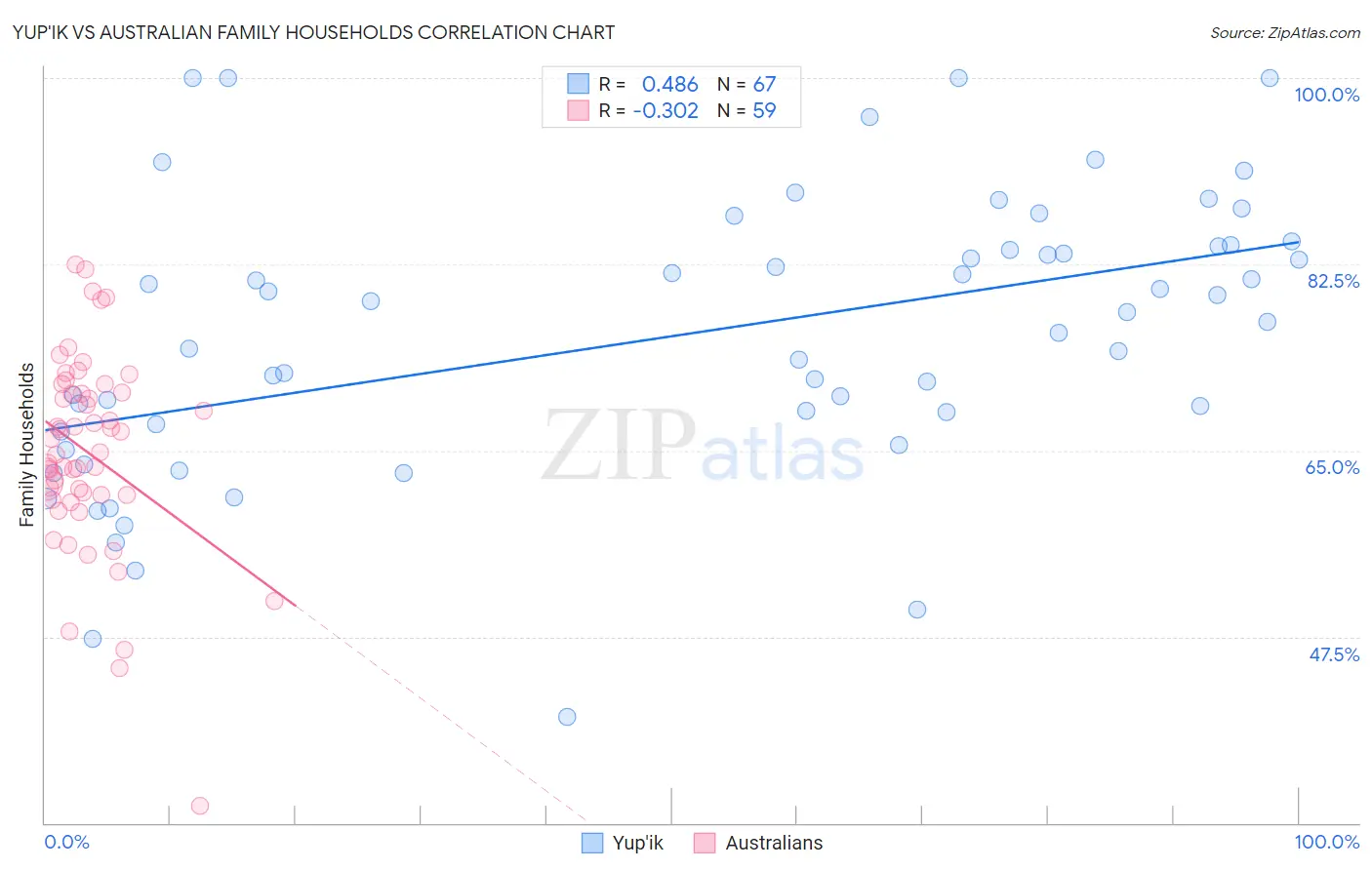Yup'ik vs Australian Family Households
COMPARE
Yup'ik
Australian
Family Households
Family Households Comparison
Yup'ik
Australians
72.4%
FAMILY HOUSEHOLDS
100/ 100
METRIC RATING
1st/ 347
METRIC RANK
62.8%
FAMILY HOUSEHOLDS
0.1/ 100
METRIC RATING
284th/ 347
METRIC RANK
Yup'ik vs Australian Family Households Correlation Chart
The statistical analysis conducted on geographies consisting of 39,956,676 people shows a moderate positive correlation between the proportion of Yup'ik and percentage of family households in the United States with a correlation coefficient (R) of 0.486 and weighted average of 72.4%. Similarly, the statistical analysis conducted on geographies consisting of 224,034,220 people shows a mild negative correlation between the proportion of Australians and percentage of family households in the United States with a correlation coefficient (R) of -0.302 and weighted average of 62.8%, a difference of 15.2%.

Family Households Correlation Summary
| Measurement | Yup'ik | Australian |
| Minimum | 40.0% | 31.6% |
| Maximum | 100.0% | 82.4% |
| Range | 60.0% | 50.9% |
| Mean | 75.6% | 64.8% |
| Median | 77.1% | 64.9% |
| Interquartile 25% (IQ1) | 66.8% | 60.9% |
| Interquartile 75% (IQ3) | 84.2% | 70.5% |
| Interquartile Range (IQR) | 17.4% | 9.6% |
| Standard Deviation (Sample) | 13.2% | 9.3% |
| Standard Deviation (Population) | 13.1% | 9.2% |
Similar Demographics by Family Households
Demographics Similar to Yup'ik by Family Households
In terms of family households, the demographic groups most similar to Yup'ik are Spanish American Indian (71.2%, a difference of 1.8%), Tongan (69.6%, a difference of 4.0%), Yakama (69.3%, a difference of 4.5%), Yuman (69.3%, a difference of 4.5%), and Immigrants from Mexico (69.1%, a difference of 4.8%).
| Demographics | Rating | Rank | Family Households |
| Yup'ik | 100 /100 | #1 | Exceptional 72.4% |
| Spanish American Indians | 100.0 /100 | #2 | Exceptional 71.2% |
| Tongans | 100.0 /100 | #3 | Exceptional 69.6% |
| Yakama | 100.0 /100 | #4 | Exceptional 69.3% |
| Yuman | 100.0 /100 | #5 | Exceptional 69.3% |
| Immigrants | Mexico | 100.0 /100 | #6 | Exceptional 69.1% |
| Mexicans | 100.0 /100 | #7 | Exceptional 69.0% |
| Immigrants | Fiji | 100.0 /100 | #8 | Exceptional 68.8% |
| Native Hawaiians | 100.0 /100 | #9 | Exceptional 68.4% |
| Immigrants | Philippines | 100.0 /100 | #10 | Exceptional 68.3% |
| Immigrants | Central America | 100.0 /100 | #11 | Exceptional 68.3% |
| Koreans | 100.0 /100 | #12 | Exceptional 68.3% |
| Pueblo | 100.0 /100 | #13 | Exceptional 68.2% |
| Immigrants | Cuba | 100.0 /100 | #14 | Exceptional 68.2% |
| Assyrians/Chaldeans/Syriacs | 100.0 /100 | #15 | Exceptional 68.2% |
Demographics Similar to Australians by Family Households
In terms of family households, the demographic groups most similar to Australians are Immigrants from Denmark (62.9%, a difference of 0.040%), New Zealander (62.9%, a difference of 0.050%), Estonian (62.9%, a difference of 0.080%), Mongolian (62.8%, a difference of 0.10%), and British West Indian (62.8%, a difference of 0.13%).
| Demographics | Rating | Rank | Family Households |
| Ottawa | 0.3 /100 | #277 | Tragic 63.0% |
| Immigrants | Belgium | 0.2 /100 | #278 | Tragic 63.0% |
| Immigrants | Yemen | 0.2 /100 | #279 | Tragic 63.0% |
| Immigrants | Bulgaria | 0.2 /100 | #280 | Tragic 63.0% |
| Estonians | 0.2 /100 | #281 | Tragic 62.9% |
| New Zealanders | 0.1 /100 | #282 | Tragic 62.9% |
| Immigrants | Denmark | 0.1 /100 | #283 | Tragic 62.9% |
| Australians | 0.1 /100 | #284 | Tragic 62.8% |
| Mongolians | 0.1 /100 | #285 | Tragic 62.8% |
| British West Indians | 0.1 /100 | #286 | Tragic 62.8% |
| Latvians | 0.1 /100 | #287 | Tragic 62.8% |
| Immigrants | Uganda | 0.1 /100 | #288 | Tragic 62.7% |
| Immigrants | Nepal | 0.1 /100 | #289 | Tragic 62.7% |
| Immigrants | Grenada | 0.0 /100 | #290 | Tragic 62.6% |
| U.S. Virgin Islanders | 0.0 /100 | #291 | Tragic 62.6% |